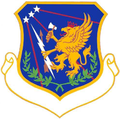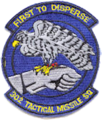BGM-109G Ground Launched Cruise Missile
| BGM-109G Gryphon (GLCM) Inertial, TERCOM | |
|---|---|
Launch platform | Transporter erector launcher |
The Ground Launched Cruise Missile, or GLCM, (officially designated BGM-109G Gryphon) was a ground-launched
Overview
The BGM-109G was developed as a counter to the mobile
History
Design and Employment
A conventionally configured cruise missile, the BGM-109 was essentially a small, pilotless flying machine, powered by a

GLCM was developed as a ground-launched variant of the
Militarily, the GLCM was targeted against fixed targets—at the outer edge of its range, the missile's flight time with its subsonic turbofan was more than 2+1⁄2 hours. The missiles were launched from an elevated launcher, with the missile ejected from its canister for about 13 seconds of solid rocket booster flight. The fins extended at 4 seconds, the air inlet and wings deployed at 10 seconds and the jet engine started at the end of the boost phase. Flying at a low level, the missile was guided by TERCOM (terrain contour matching) to the target.
This contrasted strongly with
BGM-109G personnel were trained at
NATO deployment and protests



BGM-109G missiles would be based at six locations throughout Europe; in the United Kingdom (at
Normal basing was in blast shelters at military installations. Each BGM-109G station was controlled by a Wing that consisted of a Tactical Missile Squadron (TMS), which was responsible for operation and deployment of the missiles; and a Tactical Missile Maintenance Squadron (TMMS), which was responsible for the support of the system. Each TMS consisted of several flights, made up of 69 people and 22 vehicles.[5] The missile was designed to operate in a flight with sixteen missiles. The flight would be normally on base, with the missiles and vehicles secured in the hardened storage area called the GAMA (GLCM Alert and Maintenance Area).
Four
During periods of increased tension, the flights would be deployed to pre-surveyed, classified locations in the countryside away from the base. The members of the flight would dig in, erect camouflage netting to hide the vehicles, and prepare for launch. Flight commanders were tasked to survey and select possible deployment sites, with all details closely held, and the commander selected the location preferred when the flight deployed from the base. When deployed, the flight was self-sustaining, and secured with special intrusion detection radar. The launchers (without warheads) were sent out on a number of simulated scrambles.[5]
Although deployed in the face of a range of
Intermediate-Range Nuclear Forces Treaty

Despite initial fears of greater instability, the deployment of GLCM ultimately caused Soviet leaders to enter into negotiations for, and finally, sign off on, the INF treaty. The recognition by Soviet leaders of the threat posed by the GLCM and Pershing II missiles made them far more inclined to agree to negotiate their own intermediate-range weapons, especially the SS-20, out of service, in exchange for the elimination of the threat posed by the GLCM and the Pershing II.[8]
Unlike

GLCM was removed from Europe beginning in 1988, and over the next three and a half years all units were transported to Davis Monthan AFB and destroyed or converted into displays by 1991. Eight missiles survive for inert static display only.[5]
In February 2018,
USAF BGM-109G GLCM units
- (1985–1990)
- 89th TMS (80 missiles) 50°02′37″N 007°25′32″E / 50.04361°N 7.42556°E
- 303d Tactical Missile Wing - RAF Molesworth, United Kingdom (1986–1989)
- 87th TMS (64 missiles) 52°22′55″N 000°25′41″W / 52.38194°N 0.42806°W
- 485th Tactical Missile Wing - Florennes Air Base, Belgium (1984–1989)
- 71st TMS (48 missiles) 50°13′34″N 004°39′01″E / 50.22611°N 4.65028°E
- 486th Tactical Missile Wing - Woensdrecht Air Base, Netherlands (1987–1988)
- No Tactical Missile Squadron assigned (48 missiles assigned/0 Deployed)51°26′21″N 004°21′09″E / 51.43917°N 4.35250°E
- 487th Tactical Missile Wing - Comiso Air Base, Italy (1983–1991)
- 302d TMS (112 missiles) 36°59′42″N 014°36′48″E / 36.99500°N 14.61333°E
- 501st Tactical Missile Wing - RAF Greenham Common, United Kingdom (1982–1991)
- 11th TMS (96 missiles) 51°22′42″N 001°18′07″W / 51.37833°N 1.30194°W
- 868th Tactical Missile Training Squadron, Activated 1 July 1981
- Assigned to 868th Tactical Missile Training Group, 1 October 1985
- Components: 868th TM Training Squadron, 868th TM Maintenance Squadron, 868th Student Squadron
- Davis-Monthan AFB, Arizona, inactivated on 31 May 1990
- An area near Fort Huachuca was used for field training for GLCM operations. [13]
Note: Each GLCM squadron was further subdivided into several flights. Each flight included 2 Launch Control Vehicles (LCC) and 4 Transporter Erector Launchers (TEL), totalling 16 missiles per flight. Each TEL could carry 4 missiles.[14][15]
-
38th Tactical Missile Wing
-
303d Tactical Missile Wing
-
485th Tactical Missile Wing
-
486th Tactical Missile Wing
-
487th Tactical Missile Wing
-
501st Tactical Missile Wing
-
868th Tactical Missile Training Group
-
11th Tactical Missile Squadron
-
71st Tactical Missile Squadron
-
87th Tactical Missile Squadron
-
89th Tactical Missile Squadron
-
302d Tactical Missile Squadron
-
868th Tactical Missile Training Squadron
See also
- Typhon missile launcher
- Tomahawk SLCM
- SSC-X-4/RK-55
- List of nuclear weapons
Notes
- ^ The Mikoyan MiG-31's Zaslon radar has look-down/shoot-down function, and was specifically designed to intercept low-flying bombers and cruise missiles. Same radar function on the Beriev A-50.
References
- ^ a b Cochran, Arkin & Hoenig 1984, pp. 179–184.
- ^ "Raytheon AGM/BGM/RGM/UGM-109 Tomahawk". Designation systems.
- ^ "The W80 Warhead", USA, Nuclear weapon archive.
- ^ Sandia Weapon Review: Nuclear Weapon Characteristics Handbook (PDF) (Report). Sandia National Labs. September 1990. p. 78. SAND90-1238.
- ^ a b c d e General Dynamics/McDonnell Douglas BGM-109G "Gryphon" Ground-launched Cruise Missile Archived 17 February 2006 at the Wayback Machine
- ^ Grier, Peter. "The Short, Happy Life of the Glick-Em". Air Force Magazine. 85 (July 2002): 70–74.
- ^ "ICBMs". Archived from the original on 7 October 2009.
- JSTOR 1986108.
- ^ "INF Theater / Operational Missiles". Russian / Soviet Nuclear Forces. FAS.
- ^ Pentagon Confirms It’s Developing Nuclear Cruise Missile to Counter a Similar Russian One. Defense One. 2 February 2018.
- ^ Pengelly, Martin (20 October 2018). "Trump says US will withdraw from nuclear arms treaty with Russia". The Guardian. Retrieved 20 October 2018.
- ^ "INF nuclear treaty: US pulls out of Cold War-era pact with Russia". BBC News. 2 August 2019.
- ^ "Air Force Magazine" (PDF).
- ^ AAFM Newsletter, Volume 12, Number 4, dated December 2004, article "GLCM Part I" by Col (Ret) Charlie Simpson. Archived 30 September 2011 at the Wayback Machine
- ^ "The Missile Forums • View topic - GLCM Unit Order of Battle". Archived from the original on 16 March 2012. Retrieved 25 June 2011.
![]() This article incorporates public domain material from the Air Force Historical Research Agency
This article incorporates public domain material from the Air Force Historical Research Agency
Bibliography
- Cochran, Thomas; Arkin, William M.; Hoenig, Milton M. (1984). Nuclear Weapons Databook Volume I: U.S. Nuclear Forces and Capabilities. Natural Resources Defense Council. ISBN 0-88410-173-8.













